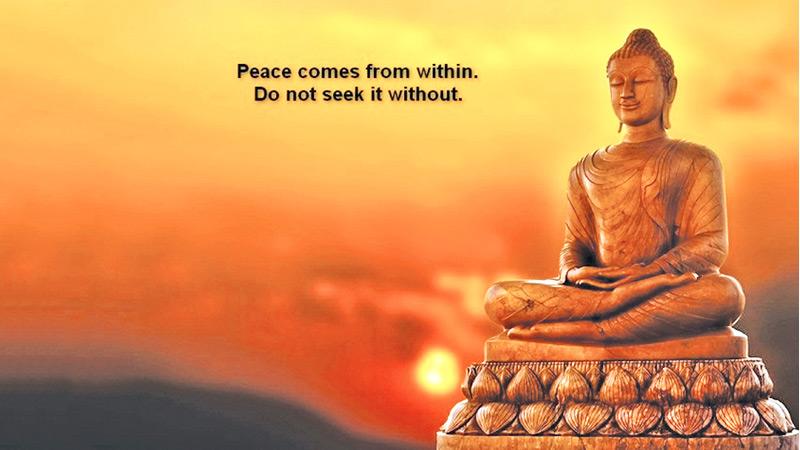
In Buddhism there are many grades of truths. There are absolute truths, agreement or conventional truths and noble truths. (It is said that only two kinds of truths – conventional and absolute exist). Absolute truths concern the totality of the universe. They are citta, cetasika, rupa, nibbana- mind, minding, matter and space. Conventional truths are the truths agreed upon by tacit or express, or common use agreement. Thus the word ‘boy’ is a conventional sound/figure to represent a male member of a certain age of the human species. That holds effective for some people only showing that it is just an agreement. All these are truths not lies. But the noble truths are very special truths to ‘emerge surpassing all other truths by themselves’ and to be unearthed by a Buddha of any kind but can be preached/made available to others by a Buddha only. They can be called ‘social truths’ or ‘life truths.’ Apart from society and life these truths also evaporate. Therefore, the four noble truths are said to reside entirely within the fathom-size body. But these noble truths are fused together with the totality of the religious concepts of ethics in a way possible to themselves or to a Buddha. The further tying of paramattha and paññtti is a still deeper skill capable only by a Lord Buddha.
 Some of the paññatti are laws framed for various purposes by the Buddha to rhyme with the paramattha truths, which are absolute truths and noble truths. Our effort should be to reach that understanding. The very word understanding is superficial, as in other affairs of our ordinary life.
Some of the paññatti are laws framed for various purposes by the Buddha to rhyme with the paramattha truths, which are absolute truths and noble truths. Our effort should be to reach that understanding. The very word understanding is superficial, as in other affairs of our ordinary life.
In the understanding of the four noble truths it is something experienced by every molecule of the body and whole of the mind at once. So much so that the natural impulse of man to ‘swim stream’ in four stages. With the first stage of understanding the man enters into the group of Ariyas in the world. This is done without causing any sort of incapacitation but by sheer understanding of the past, present and future of all existence in a moment. As for the fusion of paramattha and paññatti, one will understand that there is no institution as nirodha or nibbana as understood in secular terminology. They are mere acts of naming according to one language. Truth is purely free from sounds, figures or ways of their arrangements to make a language.
Now, our aim is not to explain the four noble truths. The mainstream of this writing is the examination of Buddhism in practice, where we examine whether these four noble truths are concepts restricted to the considerations of religious thoughts only. It is not so. There is a significant second name generally used for these four noble truths – the middle path. Middle Path is not actually all four of the noble truths but only one of the four. But for an average man the understanding of the four noble truths is something too difficult. He has no time as he is engaged in the struggle of his life including earning his living. He is not intelligent enough to grasp the noble truths in their correct perspective.
He cannot devote enough time to develop concentration and wisdom. But he is witty enough to recognize and admit that the clergy, shunning all taste of general life and devoting the whole of life in pursuit of supra mundane something noble, are to be listened to. This saddhā is one of the most essential ingredients in the advancement of the spiritual ladder. He is quite content if he is told ‘what he should do and what he should not do’ for the betterment of his lay life. This is entirely given in the middle path. Hence I feel the middle path is the essence in the practice of Buddhism. Middle path is a unique fusion of philosophy, religion and ethics.
All the other noble truths are mere matters for understanding, rather too far away from the common man. He wants short and swift answers on what should be his course of action. This course of action is fused in the magga truths of the four noble truths, which is the eight-fold path.
The middle path is the eight-fold path. These are a little more explained in thousands of books in many languages. How can the middle path be explained as the guiding star in all problems of man’s life? Here too, we have to think and examine. As everybody is too much concerned now with politics we may examine what has happened to the two powerful political camps of the world that turned the world upside down in the last centuries of the first millennium? Both camps were forced, by circumstances, to come to a middle path. So how much human labour was wasted? How much human labour was devoted for destruction? The lesser powers that followed those extremes are still unable to adjust their own policies to the new circumstances. Perhaps, their greatest difficulty is to wash away the dirt they filled into the brains of the masses as finalities in political theories and practices. This brainwashing was one of the important tasks they expected to undertake after ‘complete socialism’, that is, when power was entirely in their hands.
Political parties of such countries, lacking in philosophies of their own, still stick to the hackneyed theories for some new spirit.
The writer is attached to the Department of Philosophy, Faculty of Arts, University of Peradeniya
